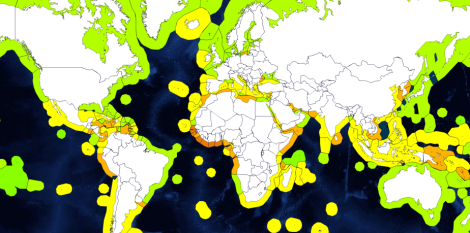There is no reason that I should prepare an introduction to the Ocean Health Index when Harrison Ford is perfectly capable of doing so. Watching this video will make you feel like you’re a sixth-grader on a field trip to an aquarium.
The Ocean Health Index is an endeavor by Conservation International, the New England Aquarium, and the National Geographic Society to establish a measurement system for the health of the world’s oceans, a baseline index against which future changes can be measured. The project’s (absolutely gorgeous) website explains up-front how we’re doing. On a scale of 0 to 100, our oceans are at 60.
So what does that mean? The OHI assesses how the ocean areas off countries’ coastlines are faring according to 10 goals: water cleanliness, biodiversity, food provision, artisanal fishing opportunities, natural products, carbon storage, coastal protection, coastal livelihoods, tourism, and sense of place. To compute the scores for each goal, several dozen components — things like coral reef health, fisheries management, marine jobs, acidification — were evaluated by researchers from the University of Santa Barbara and the University of British Columbia. Each country is scored on each goal on a 0-to-100 scale.
The OHI provides a ranking of how various countries fare. One of the best indicators of how well a country or region will fare is the extent to which it is industrialized; the best indicator is whether or not it is inhabited. Here’s what Santa Barbara’s Benjamin Halpern told National Geographic:
Halpern explained that Germany received a relatively high score of 73 even though there’s a lot of industrial use of the country’s waters. The key is that Germany’s marine region is also well protected and provides high value to its people.
On the other hand, the uninhabited Jarvis Island scored an 86, in large part because its waters are so healthy.
Jarvis, a remote U.S. territory in the Pacific Ocean, got the highest score. Second place went to the U.S. Pacific Territories. Or, sorry — the U.S. Uninhabited Pacific Territories. The inhabited ones ranked 22nd.
The United States proper is ranked 26th in the world, with a score of 63. Not terrible; better than the global average. It’s worth noting, however, that our tourism and recreation is rated a 1. Did we mention that higher scores are better? This seems … low. So if one entire coast of our country were suddenly coated with sewage and mined to kill any possible offshore life, we’d only lose a point in the rankings? Hm. We’re considering filing a complaint with the judges.
The OHI’s real value will emerge over time, as we both continue to measure the factors under consideration — itself a thing of value — and compare future ocean quality to how it has been in the past. At ArsTechnica, they called this a “Dow Jones for ocean health.” If that’s how you want to look at it, a little advice: Buy short.




